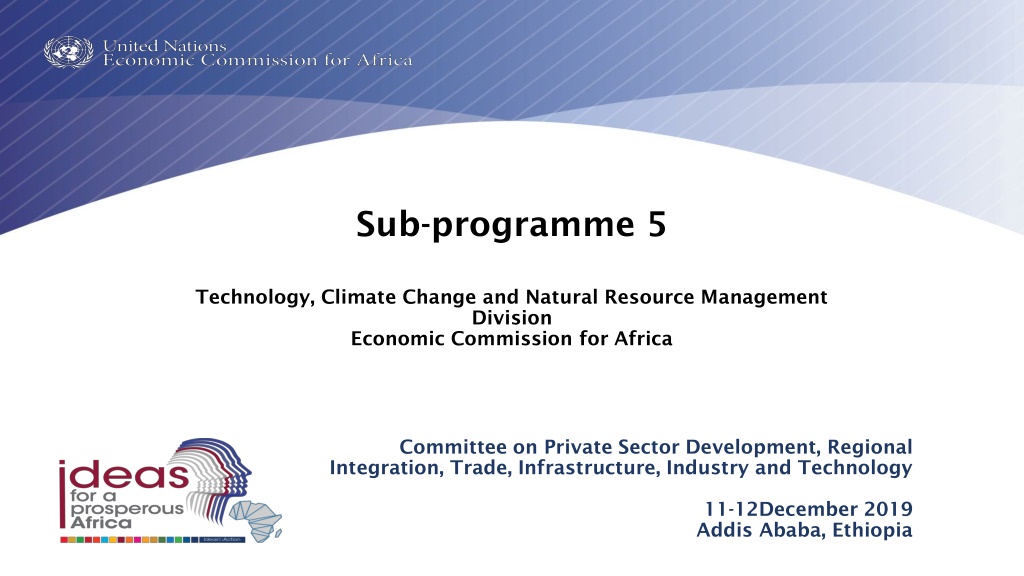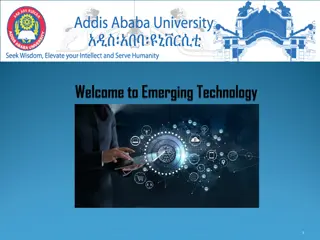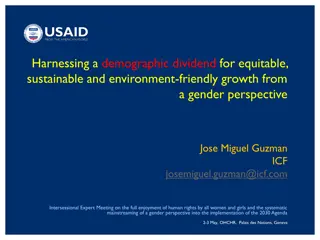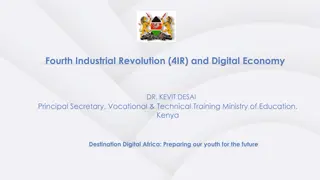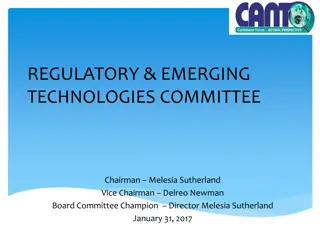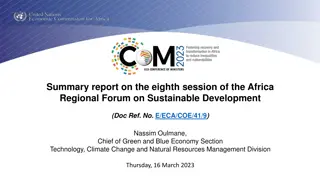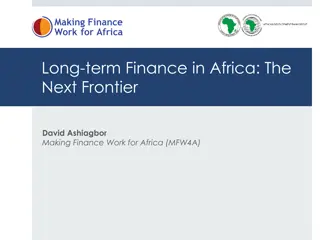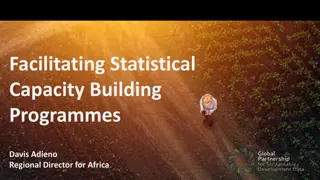Harnessing Emerging Technologies for Africa's Development
Exploring the potential opportunities and implications of emerging technologies such as digital and nanotechnologies in Africa. Highlighting the current challenges, the need for regional integration, and the importance of policy alignment to facilitate investment in key infrastructure and competencies. The discussion focuses on the economic, social, and environmental benefits these technologies can bring to the continent, aiming to bridge the gap and propel Africa towards technological advancement and economic transformation.
Download Presentation

Please find below an Image/Link to download the presentation.
The content on the website is provided AS IS for your information and personal use only. It may not be sold, licensed, or shared on other websites without obtaining consent from the author. Download presentation by click this link. If you encounter any issues during the download, it is possible that the publisher has removed the file from their server.
E N D
Presentation Transcript
Sub-programme 5 Technology, Climate Change and Natural Resource Management Division Economic Commission for Africa Committee on Private Sector Development, Regional Integration, Trade, Infrastructure, Industry and Technology 11-12December 2019 Addis Ababa, Ethiopia
Outline Background Objectives Emerging Technologies and Opportunities they present An Overview of Opportunities and measure To Harness Digital Technologies An Overview of Opportunities and measure To Harness Nanotechnologies Why a Regional Approach Matters Going forward
Background Earlier Efforts in digital and nano-technologies ECA research on Digital Technologies Open Data Fintech Artificial Intelligence Blockchain ECA research and support for nanotechnology Support work on nanomedicine Research on Nanotechnology NanoSmat Africa Research on R&D funding
Background A concern Africa is failing behind 2% of global researchers 1% of global expenditure on R&D AU target of 1% of GDP not met (estimate= 0.5% of GDP) 0.3% of global $2.3 trillion high-tech exports value Agenda 2063 target 50% of manufactures- estimate= 10-15% 0.2% of global $423 billion payment (BoP) for IP Low tech acquisition 0.07% of global $380 billion receipts (BoP) for IP Low tech export It has implications on ability to catchup or leapfrog.
STI has Implication for Economic Transformation Manufacturing, value added (% of GDP) 35 30 25 20 15 10 5 0 1970 1975 1980 1985 1990 1995 2000 2005 2010 2015 Kenya Malaysia Thailand South Africa Turkey Nigeria Tunisia
Objectives What and where are the economic, social and environmental potential opportunities of emerging technologies for Africa? What are the key attributes and benefits of emerging technologies; Are the existing policy and governance arrangements fit for purpose ?; How can regional integration help to bring about investment in key infrastructure and competencies?
Focus on Digital and Nano- Technologies Convergence of technologies Almost everything digital is powered by or contains nanotech Helped shrink digital devices- size, weight, volume Pack more processing and storage power Multidisciplinary Nanotech will be big without digital
What and where are the opportunities from emerging technologies?
Generally Attributes of Emerging Technologies? Make Public Sector Smart -agile, user-friendly, trustworthy Enhance Private Sector creativity, innovative, diversified Create New Opportunities new industries, sectors and economies Bring about social change- empowering people, increasing freedoms Disrupt and Equalize Equal opportunities for learning and catching up Save the Environment and Enhance Sustainability Advance Sustainable Development
What are Emerging Technologies? Biotechnologies Personalized health monitoring technology, medical and bioimaging, stem medicine and tissue engineering etc Advanced materials Nanomaterial, nanodevices, carbon nanotubes and graphene etc. medicine, bioinformatics, functional additive materials, manufacturing, cells, regenerative Digital technologies Cloud computing, computing, robotics, big data, analytics, the Internet of Things, artificial intelligence and quantum computing. Energy and environment Smart grids, autonomous vehicles, drones, precision agriculture, biofuels, advanced energy storage technologies, fuel cells, photovoltaics, hydrogen energy etc blockchain, grid
Opportunities in Digital Technologies Type Activities Examples Core Digital Sector Designing, Producing and Installing ICT infrastructure; Platforms; Devices Manufacturers of Semiconductors, Computers, Software Digital Economy Offering Digital Services and Business Processes Cloud Storage and Service Providers; Payment Systems Digitalized Economy Converting and Increasing Use of Digital in Organizational Processes Online education, online or virtual healthcare; booking services online; e-banking, online shopping,
Is African Missing the Digital Opportunities? Africa s share Core R&D in digital technology is negligible Design and manufacturing of IT products is negligible Digital Economy Investment in blockchain = >1% Cloud computing and storage = 1.2% Digitalized Economy Mobile penetration = 44% of population Internet penetration = 39.8% population Mobile payment = 45.6% of global m-money accounts but low volume of the global mobile payments (45% of $1.9 trillion) Internet traffic = > 1% of global E-commerce= >1% of global
Realizing Digital Economy Opportunities Africa is almost absent in core sectors Efforts to attract FDI and technology transfer, invest in R&D and training programme Africa is far behind in digital economy Cloud storage is growing; m-payments have grown but e-Payments remain limited. Therefore, government incentives to promote cloud services and Fintech may be needed Africa has mixed performance in digitalized economy Governments need to strategically invest in digital infrastructure, skills and services, adopt digital IDs and payment systems, support SMEs and public institutions. This could improve quality and security, reduce costs and enhance trust.
What is a nanotechnology product or service? Gongali Model, Tanzania PST Sensors, Cape Town NanoTech Egypt; Cairo Tanzanian that returned home to set up a water purification plant that employs nanofilters. Is a spin-off of Cape Town University that makes heat sensors enabled by its world s first technology Manufactures custom-tailored nanomaterials and solutions.
Nanotechnology opportunities Nano- Nanotools Nanomaterials Nano-enabled intermediates Equipment and software for visualizing, manipulating and modelling Nanoimprint lithography equipment Unprocessed forms of nanoscale structures Intermediate products with nanoscale features Finished goods incorporating nanotechnology Nanoparticles, quantum dots and nanotubes Memory and logic chips, superconducting wires, fabrics Electronic devices, medicine, plastics, cars
Patent analysis (% of global patents by application) Electronics Medicine/veterinary Power generation Coatings Catalysis Diagnostics Energy storage Electrodes/electrolytes Lighting devices Sensors (excluding biosensors) Drug delivery Optoelectronics Electronic paper Engineering Reinforced materials Filtration/bioseparation Pigments/inks/dyes Fuel cells Nanobiotechnology Tools/devices Polymers 0 1 2 3 4 5 6 7 8 9 10 11 12 13 14 15
Top 10 Applications of Nanotechnology for Developing Countries Primary SDG 1. Energy storage, production, and conversion 7 (Energy) 2. Agricultural productivity enhancement 2 (Food) 3. Water treatment and remediation 6 (water) 4. Disease diagnosis and screening 3 (Health) 5. Drug delivery systems 3 (Health) 6. Food processing and storage 2 (Food) 7. Air pollution and remediation 11 (Cities) 8. Construction 9 (Infrastructure) 9. Health monitoring 3 (Health) 10. Vector and pest detection and control 3 (Health) Source: ECA based on F. Salamanca-Buentello et al., Nanotechnology and the Developing World, PLoS Medicine 2 (2003): e97.
Nanotechnology: realizing the opportunities Governance and institutional arrangements needed Human capital development Research infrastructure with clear focus nano-intermediates and enabled Creating regional research centres of excellence (e.g. in Uganda) Levering regional and global resources to build capacity Seed start-ups and nano-adopting firms
Importance of regional perspective Harmonization of standards and regulations Presenting a large market for high-tech services and firms Leveraging regional networks for R&D talents, infrastructure and knowledge Regional innovation ecosystems to drive innovation in complex area Sharing of risks and benefits
